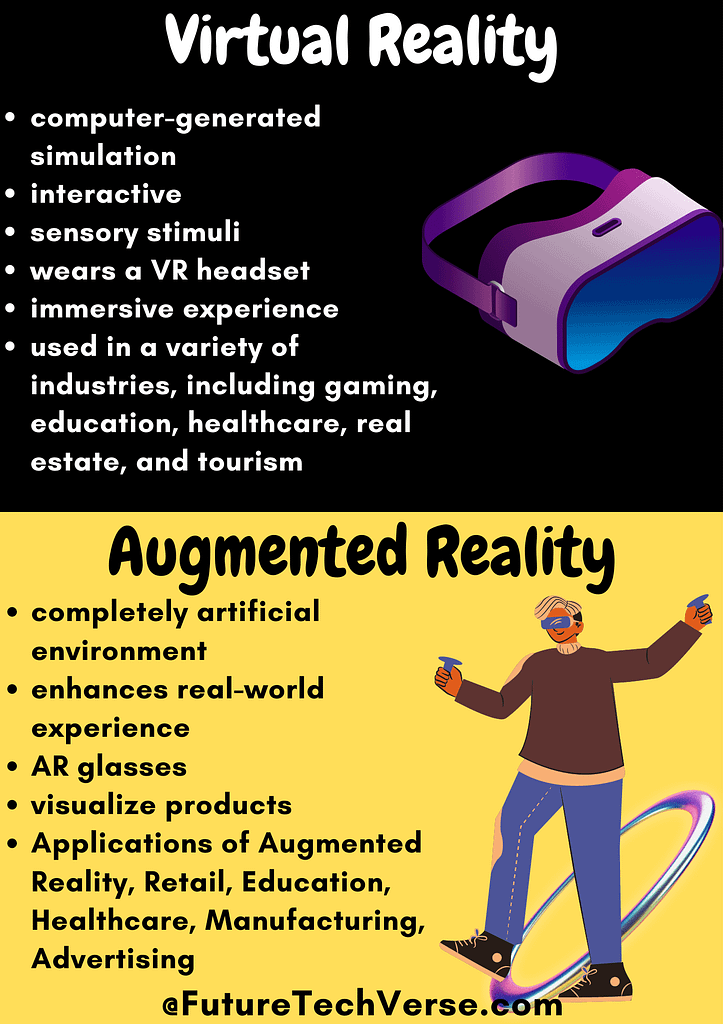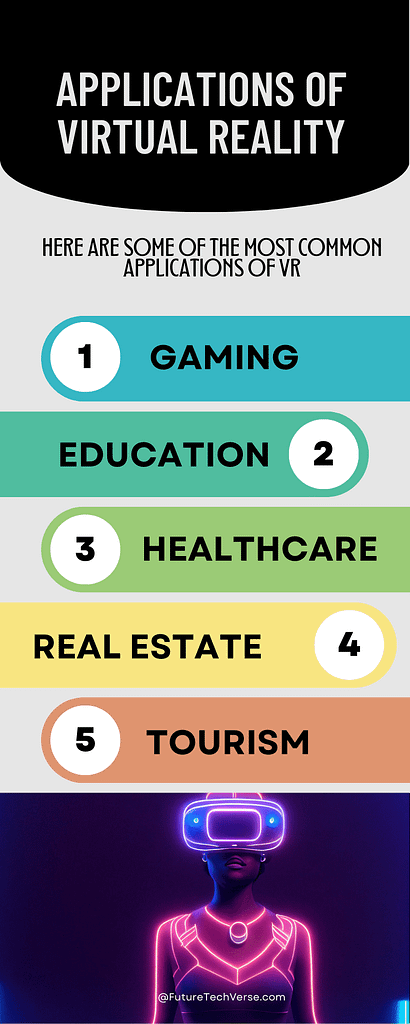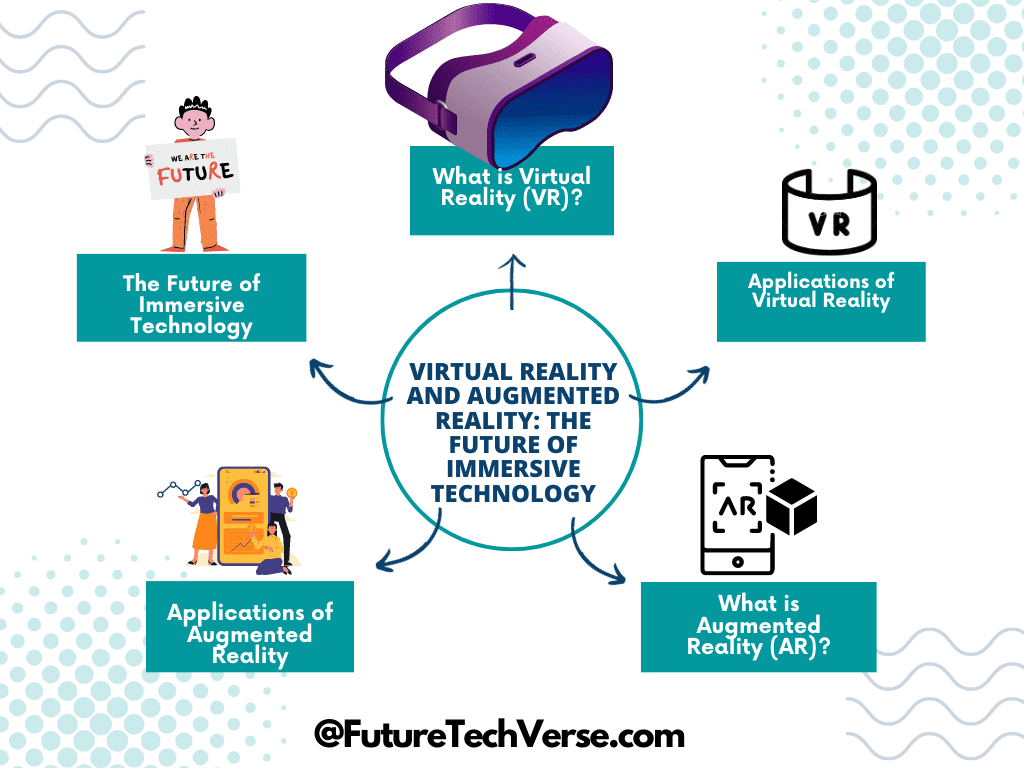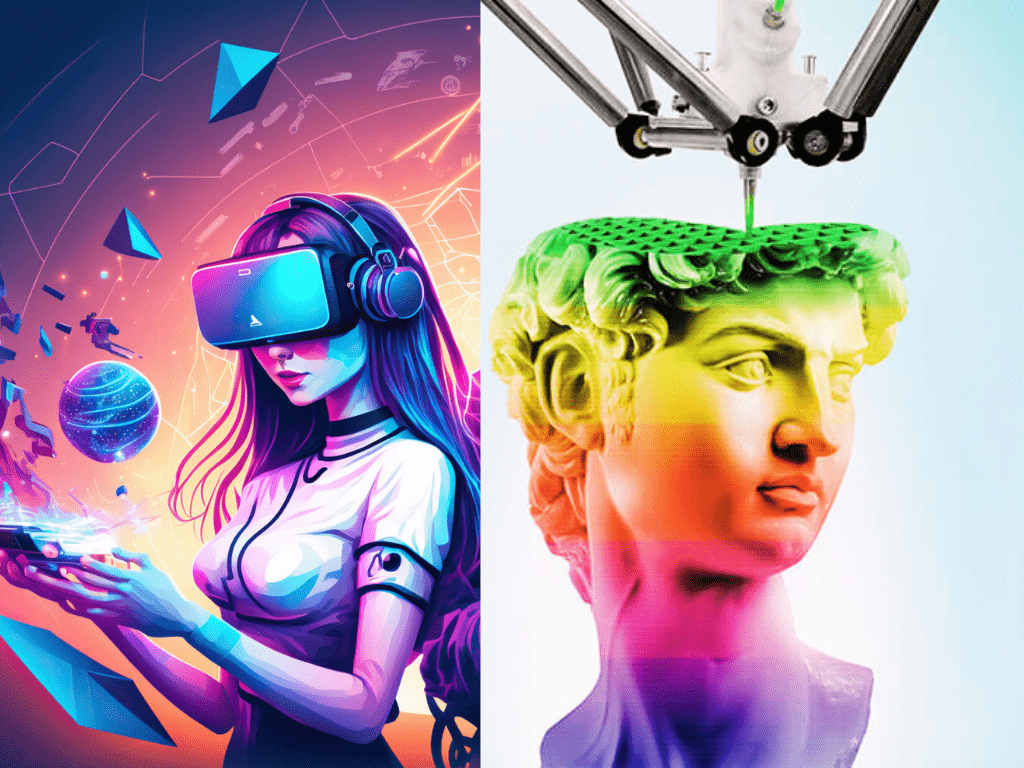Virtual reality (VR) and augmented reality (AR) are two of the most exciting technological advancements of the modern era.
These technologies are transforming the way we interact with the world, opening up new possibilities for communication, entertainment, education, and more.
In this article, we will explore the basics of VR and AR, including their definitions, how they work, and their various applications. We will also examine their potential impact on industries such as healthcare, education, and gaming.

What is Virtual Reality (VR)?
Virtual Reality (VR) is a computer-generated simulation of an environment or situation that can be experienced through a headset or other devices.
It is a three-dimensional, immersive experience that can be interactive, providing the user with a sense of presence and interaction within a virtual world.
VR technology uses a combination of hardware and software to create this experience, including head-mounted displays (HMDs), tracking systems, and input devices such as controllers or gloves.
VR can be used in a variety of industries, including gaming, education, healthcare, real estate, and tourism, to name a few. Its potential applications are constantly expanding as the technology continues to evolve.
Applications of Virtual Reality
Virtual Reality (VR) has numerous applications across various industries. Here are some of the most common applications of VR:

a. Gaming: VR gaming provides a fully immersive experience where players can interact with the game environment as if it were real. VR gaming has the potential to revolutionize the gaming industry by creating more realistic and interactive experiences.
b. Education: VR technology can be used in education to create immersive learning experiences. For example, students can use VR to explore historical sites, take virtual field trips, or practice complex procedures in a safe and controlled environment.
c. Healthcare: VR has various applications in healthcare, including pain management, therapy, and training. VR can help patients manage pain by distracting them from their discomfort with immersive experiences. It can also provide a safe environment for patients to practice exercises or procedures, without the risks associated with real-world practice.
d. Real Estate: VR technology can be used in real estate to showcase properties in a more immersive way. For example, potential buyers can take virtual tours of homes, apartments, or commercial spaces, allowing them to explore the property from anywhere in the world.
e. Tourism: VR can be used to provide virtual tours of travel destinations, allowing people to explore different parts of the world from the comfort of their own homes. This can be particularly useful for people with mobility issues, or for those who cannot afford to travel to these locations in person.
These are just a few examples of the many applications of VR technology. As technology continues to advance, we can expect to see even more innovative uses in various industries.
What is Augmented Reality (AR)?
Augmented Reality (AR) is a technology that overlays digital information or virtual objects onto the real world. Unlike Virtual Reality (VR), which creates a completely artificial environment, AR enhances the user’s real-world experience by adding computer-generated elements.
AR technology typically requires a device such as a smartphone, tablet, or AR glasses, which captures the real-world environment and adds digital information to it. AR has various applications across industries, including gaming, advertising, education, and retail.
For example, in gaming, Augmented Reality can create interactive experiences that merge the real world with virtual elements. In advertising, AR can be used to create interactive product demonstrations or immersive brand experiences.
In education, AR can be used to provide interactive and engaging learning experiences, and in retail, AR can be used to create virtual try-on experiences, allowing customers to visualize products in their own space before making a purchase.
As AR technology continues to evolve, we can expect to see even more innovative applications in various industries.
Applications of Augmented Reality
Augmented Reality (AR) technology has various applications across different industries. Here are some of the most common applications of AR:

a. Retail: AR technology can be used in retail to create virtual try-on experiences for products such as clothing or makeup. This allows customers to visualize products in their own environment before making a purchase decision. AR can also be used to provide customers with product information, reviews, or promotions in real time, enhancing their shopping experience.
b. Education: AR technology can be used in education to create interactive and engaging learning experiences. For example, students can use AR to visualize complex concepts or historical events, making learning more immersive and memorable.
c. Healthcare: AR has various applications in healthcare, including medical training, patient education, and visualization. AR can help medical professionals visualize and understand complex medical concepts, and it can also be used to educate patients about their conditions and treatments.
d. Manufacturing: AR technology can be used in manufacturing to provide workers with real-time information and guidance. For example, workers can use AR to visualize assembly instructions or maintenance procedures, reducing errors and improving productivity.
e. Advertising: AR can be used in advertising to create interactive brand experiences. For example, AR can be used to create virtual product demonstrations or to provide customers with immersive brand experiences.
The Future of Immersive Technology
Immersive technology, which includes Virtual Reality (VR) and Augmented Reality (AR), has the potential to transform various industries by creating more engaging and interactive experiences for users.
As technology continues to advance, we can expect to see even more innovative uses and applications of immersive technology in the future.
Here are some potential developments we may see in the future of immersive technology:
- Advancements in hardware: As technology continues to improve, we can expect to see more advanced hardware that will enhance the immersive experience. For example, VR headsets may become lighter and more comfortable, and AR glasses may become more sophisticated and easier to use.
- More realistic and interactive experiences: With the advancements in hardware and software, we can expect to see more realistic and interactive experiences. For example, VR may become so advanced that it will be difficult to distinguish between the virtual world and the real world. AR may also become more seamless and integrated into our daily lives.
- More applications in various industries: Immersive technology has already been used in industries such as gaming, education, healthcare, and retail. In the future, we can expect to see even more applications in various industries such as entertainment, sports, and travel.
- Increased accessibility: As the technology becomes more advanced and more affordable, we can expect to see more people being able to access immersive technology. This may lead to more widespread adoption and more innovative uses.
- Advancements in social VR: Social VR allows users to interact with each other in a virtual environment. As technology continues to improve, we can expect to see more advanced social VR experiences, which may revolutionize the way we interact with each other online.
In conclusion, the future of immersive technology is exciting and full of possibilities. As the technology continues to improve, we can expect to see more advanced and realistic experiences, more widespread adoption, and more innovative uses in various industries.
FAQs
What is Virtual Reality?
Virtual Reality (VR) is a computer-generated simulation or environment that can be interacted with by users in a seemingly real or physical way. The user typically wears a VR headset that displays images, sounds, and other sensory stimuli, providing an immersive experience of being in a virtual world.
What is Augmented Reality?
Augmented Reality (AR) is a technology that overlays digital information or objects onto the real world. AR is often used on mobile devices or smart glasses, using cameras to capture the surrounding environment and display digital content on top of it.
What is the difference between VR and AR?
The main difference between VR and AR is that VR completely immerses the user in a virtual environment, while AR adds digital information to the real world. VR usually requires a headset or a similar device, while AR can be experienced through a smartphone or other mobile device. VR is often used for gaming and entertainment, while AR has a wider range of applications such as advertising, navigation, and education.
What are the benefits of VR and AR?
VR and AR have many potential benefits, including:
- Enhanced user experience and engagement
- Improved training and education outcomes
- Increased efficiency and productivity
- Greater accessibility for individuals with disabilities
- Cost savings in various industries such as manufacturing and construction
What are the current applications of VR and AR?
VR and AR are being used in a variety of industries, including:
- Gaming and entertainment
- Education and training
- Healthcare
- Architecture and design
- Retail and marketing
- Tourism and hospitality
- Military and defense
These are just a few of the many possible applications for VR and AR, and as the technology continues to develop, there will likely be even more uses for it in the future.
Source:
- https://en.wikipedia.org/wiki/Virtual_reality
- https://en.wikipedia.org/wiki/Augmented_reality
- https://www.splunk.com/en_us/data-insider/what-are-augmented-reality-and-virtual-reality.html

